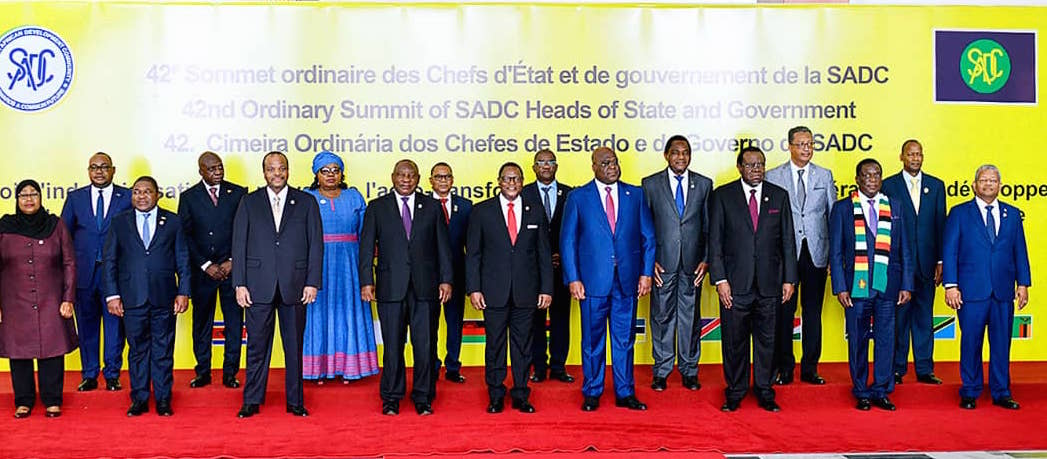|
Getting your Trinity Audio player ready…
|
President Hakainde Hichilema of Zambia has said the Southern African Development Community (SADC) has great potential to address food insecurity and increase trade in pursuit of attaining sustainable development goals (SDGs).
He made the remarks in his maiden speech during the 42nd Ordinary Summit of the SADC Heads of State and Government held in the Democratic Republic of Congo (DRC) yesterday running under the theme “Promoting industrialization through, agro-processing, mineral beneficiation, and regional value chains for inclusive and resilient economic growth.”
He said that while there is a notion that Africa is facing food insecurity as a result of the war in Ukraine, the continent has been food insecure for decades – long before any war, anywhere.
“We must, therefore, look to ourselves, before anyone else, to ensure that our people have enough food. Our land, which is rich and vast, has the potential to transform our region into a frontrunner in addressing rising food insecurity not only on the continent but around the globe at large.
“This is an opportunity that we must seize, not only in the production of food but in scaling up the agro-processing value chains within our region, in order to produce finished goods for the global market,” President Hichilema said.
He said the transition towards renewable energy, and particularly the electric vehicle revolution, also provides an opportunity for SADC countries to be at the forefront of the efforts to improve environmental sustainability.
The critical components required to manufacture EV batteries, particularly the minerals required are found in the SADC region hence the need for member states to extract the raw materials for use in the region and to transition to manufacturing and producing the batteries locally.
“I am happy to share that Zambia and the DRC are already working together to create a joint value chain for the electric mobility and clean energy sectors, which will see us produce cathode precursor materials for lithium-ion batteries. Between us, we have the nickel, cobalt, and manganese to do this right in our own countries, as opposed to exporting these minerals in their raw form.
“This is the kind of value addition and mineral beneficiation that will result in inclusive and resilient economic growth within our region. As we aim to achieve these targets, I wish to reaffirm the commitment of the Zambian Government to advancing our collective development agenda as espoused in the SADC Vision 2050 and the SADC Regional Indicative Strategic Development Plan 2020 to 2030,” President Hichilema added.
He said industrial development and market integration are critical to our region’s efforts to enter the global economy as producers of value-added goods.
The President called on the need to create conditions that allow for large-scale investment in critical regional value chains, and to develop standardized specifications for the production and exports of goods and services to enhance trade within the SADC region.
He said standardization and harmonization of trade regimes will help to significantly reduce the cost of doing business which will result in more investment and jobs for the people.
Thus, infrastructure development will provide the foundation upon which regional integration and trade will be built. Developing a modern and efficient infrastructure network will enable SADC to ease the movement of goods and services, as well as energy and other critical resources.
Zambia intends to continue collaborating with its fellow SADC Member States in expanding the existing infrastructure in line with the SADC Regional Infrastructure Development Master Plan.
The successful construction and commissioning of the Kazungula Bridge in 2021 is a success story of collaboration in infrastructure development for the region. The One Stop Border Post at Kazungula has reduced the transit time for trucks between Botswana and Zambia from about five days to just under four hours. Further, business opportunities have been created on either side of the border, while at the same time, mitigating vices synonymous with congested borders.
“As we work to alleviate border congestion, it is important that we recognize congestion at our borders as an indicator of the magnitude of the volume of trade that exists within our region.
“The onus is on us, therefore, to harness this trade efficiently to derive the immense potential benefits that exist for our people. It is a well-known fact that the greatest resource of any society is its people. Therefore, investment in Human Development, through education, health, and nutrition, is of paramount importance to the region. Our people are our greatest asset, and it is in them that we must make our biggest investments if we are to move our region forward.”
